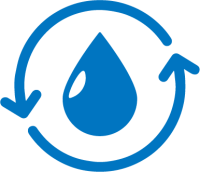Water Systems

Water infrastructure consists of both drinking water and wastewater systems, which are essential to the fulfillment of basic societal functions. Drinking water is required for sustaining life and protecting public health. Collection and treatment of wastewater is vital for preventing disease and protecting the environment.
Drinking water components include:
| Wastewater components include:
|
Water and wastewater systems provide critical services in the form of drinking water, fire suppression, and sanitary services to virtually all residential, commercial, governmental, and industrial facilities. Without water systems, faucets would run dry, toilets could not flush, public facilities and commercial buildings could not operate, and the local economy would suffer.
Drinking water and wastewater systems can vary in size and be publicly or privately owned. Both systems contain physical, cyber, and human assets necessary for operations and monitoring.
Dependencies
Water sector infrastructure supports the operations of virtually all other critical infrastructure sector systems.
Water infrastructure also relies on services from other critical infrastructure sectors, including energy, communications, transportation, chemical, information technology, dams, and critical manufacturing.




